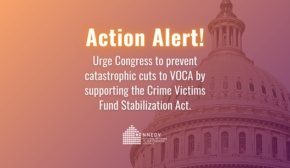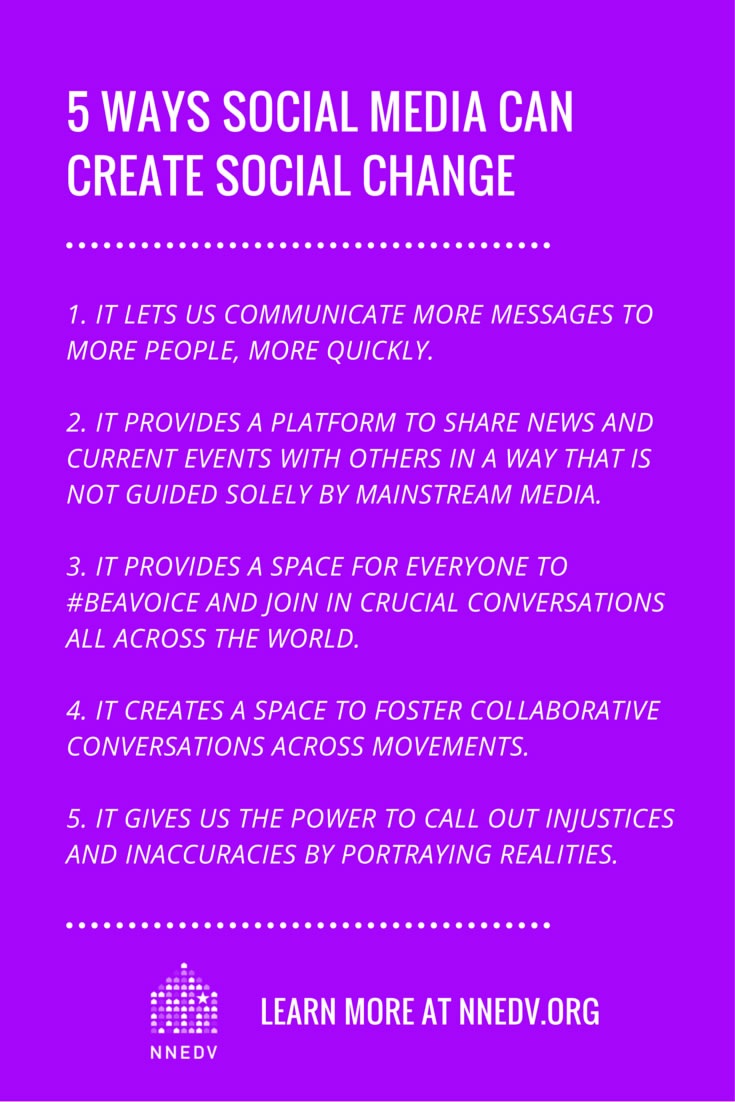Social Media for Social Change: 5 Ways Social Media Can Create Social Change
June 29, 2016
While some may argue that “hashtag activism,” or activism through social media, is not “real” or effective, the National Network to End Domestic Violence (NNEDV) disagrees. Through centering social change in social media, we can dismantle power structures that perpetuate injustices.
1. Social media lets us communicate more messages to more people, more quickly.
Survivors, like Emma Sulkowicz and Emma Murphy, are able to share their stories quickly with a large audience – communicating the realities of domestic violence and sexual assault with more people. These stories increase awareness and let other survivors know that they are not alone.
2. Social media provides a platform to share news and current events with others in a way that is not guided solely by mainstream media.
Mainstream media often gets the story wrong – perpetuating stereotypes and making excuses for perpetrators. Social media enables survivors, allies, and advocates to react and respond to current events, share relevant resources and information often not included in mainstream news, and use language that clarifies that the perpetrator is accountable for their actions through unbiased communication.
For many survivors, speaking out may not be a safe option; however, social media can provide a platform in which they can still have a voice and share their stories, while maintaining their anonymity. In a recent example, a survivor shared an open letter she wrote to her Stanford attacker in court. This letter – and its many responses – was widely shared across many social media platforms, generating so much attention that Vice President Biden wrote an open letter back to her commending her strength, bravery, and candor. We may not have heard much about this case if we relied solely on reports from mainstream media, or we would have likely heard biased reports that minimize the actions of the assailant. Her open account gave a glimpse to the world of a sexual assault, investigation, and court process from the perspective of the victim.
3. Social media provides a space for everyone to #BeAVoice and join in crucial conversations all across the world.
Social media is a very accessible way for many individuals to be activists: for those who may not feel like they have voice otherwise, for those with transportation limitations, for those who cannot leave their homes, or for those who do not have ample free time, social media provides a unique platform for users to express solidarity with political movements, report directly on current events, and share information and resources. We saw an example of the international reach of social media with the hashtag, #BringBackOurGirls, which inspired such activists as First Lady Michelle Obama.
4. Social media creates a space to foster collaborative conversations across movements.
Social media makes collaboration engaging and accessible to activists and communities. One way NNEDV collaborates with partners across movements is through Twitter Chats, where we host and participate in discussions on intersectional issues that affect survivors of domestic violence. Our latest Twitter Chat was hosted during Women’s History Month and focused on violence prevention and safety in both English and Spanish. (See highlights from our #prev4WHM chat here.)
5. Social media gives us the power to call out injustices and inaccuracies by portraying realities.
Hashtags have the ability to transform individual movements into unified, strong forces. For example, the hashtag, #SayHerName came out of the Black Lives Matter movement, and was successful in raising awareness about the extreme violence against Black women that has not garnered the same level of media attention. As the hashtag gained momentum, other movements, such as anti-gun violence and anti-violence against women organizations have adopted this hashtag, uniting movements.
Hashtags such as #WhyIStayed and #MaybeHeDoesntHitYou were groundbreaking in communicating the complexities of domestic violence. These hashtags gave survivors the opportunity to share their experiences, and dispel stereotypes and inaccuracies about domestic violence. Sharing these experiences addresses victim blaming sentiment such as the age-old question, “why doesn’t she just leave?”
Together, we can harness the power of social media to create the social change necessary to bring us to a world where gender-based violence no longer exists. #SquadGoals
By: Morgan Dewey, Development & Communications Coordinator, National Network to End Domestic Violence (NNEDV)







